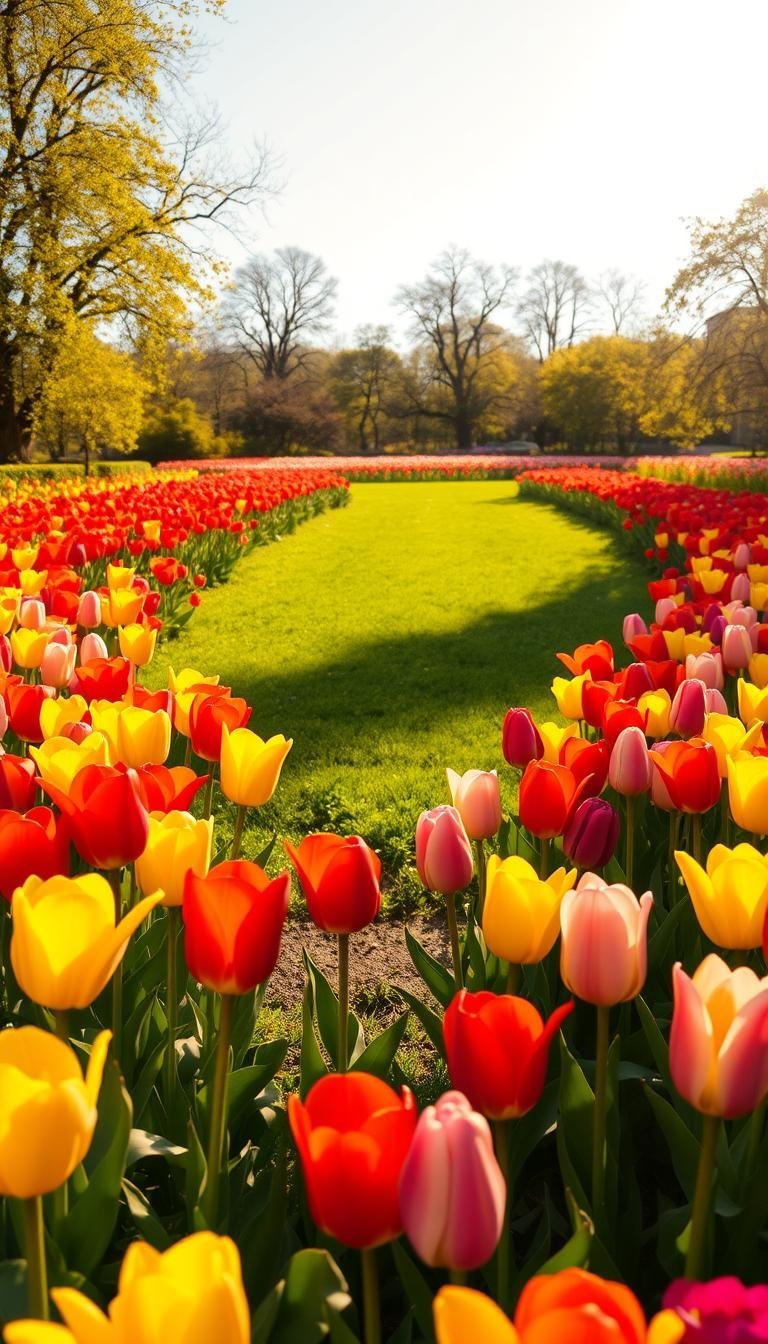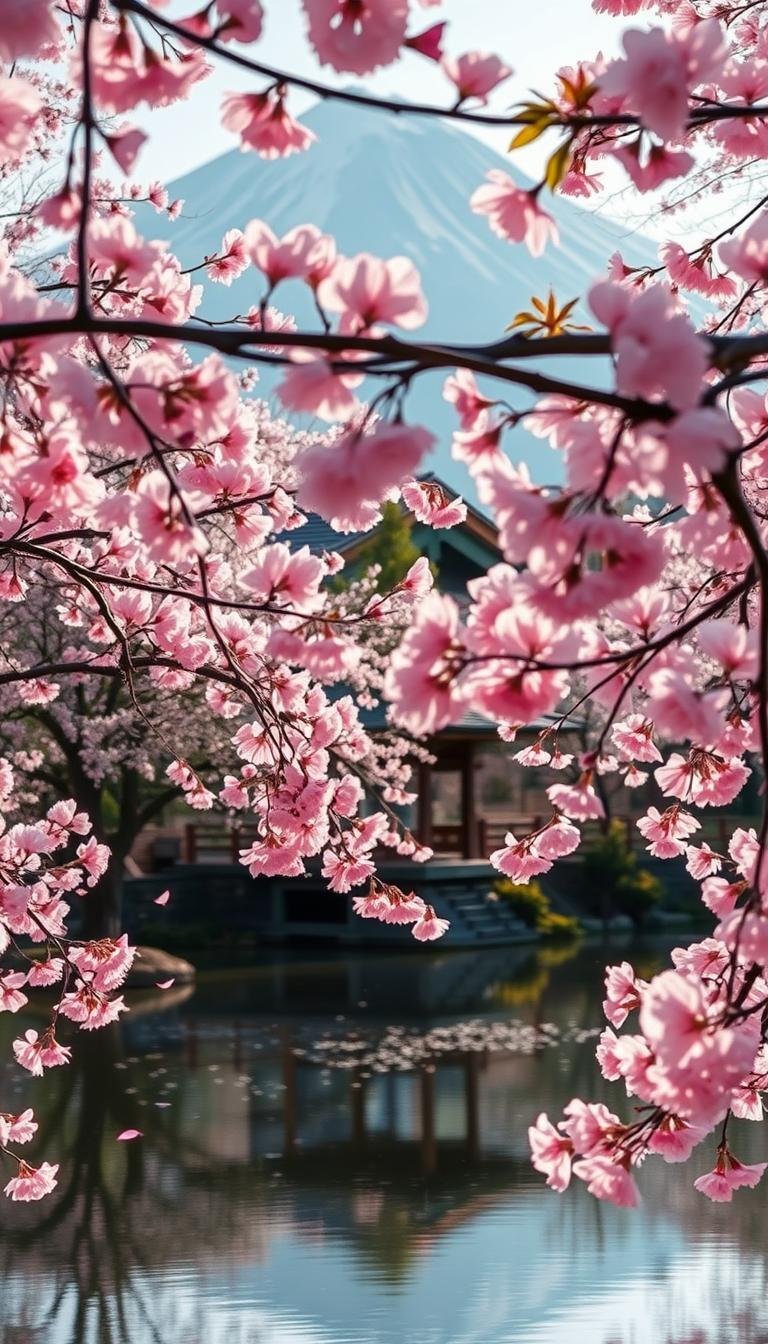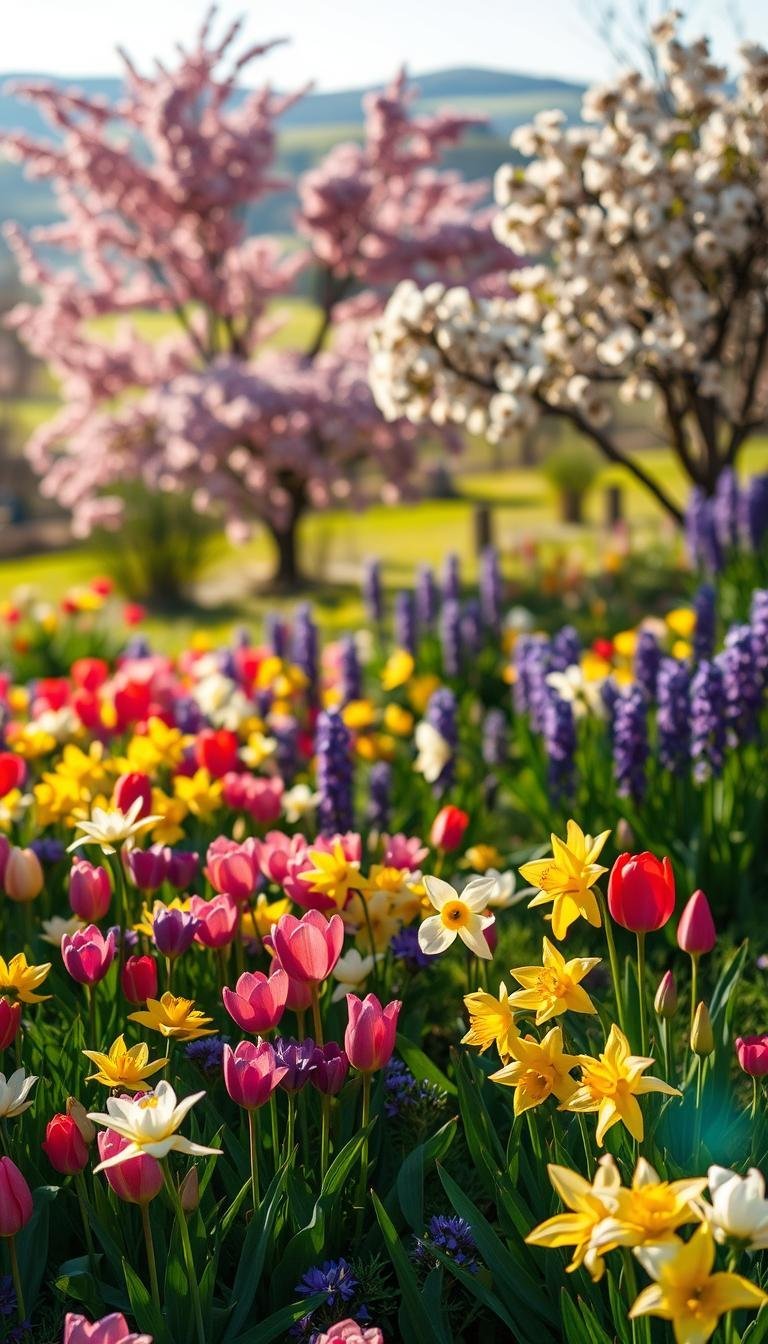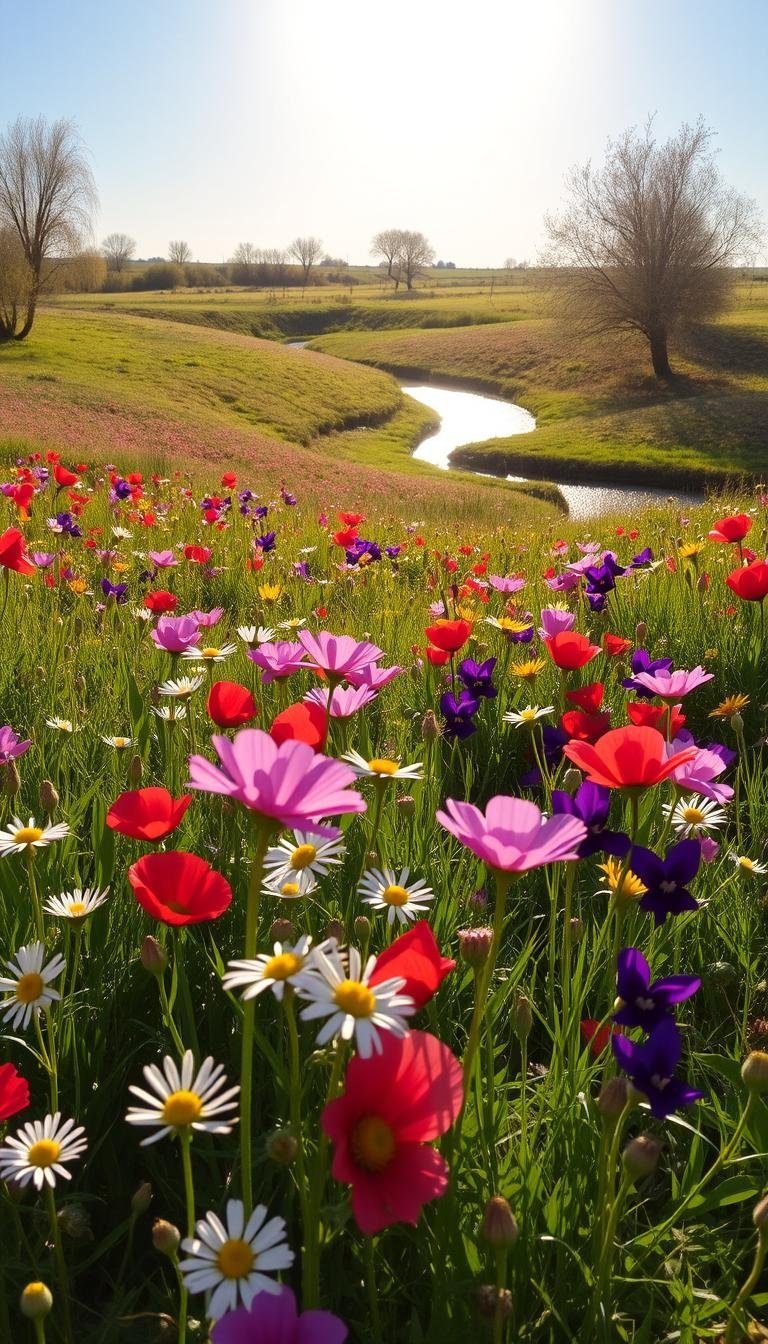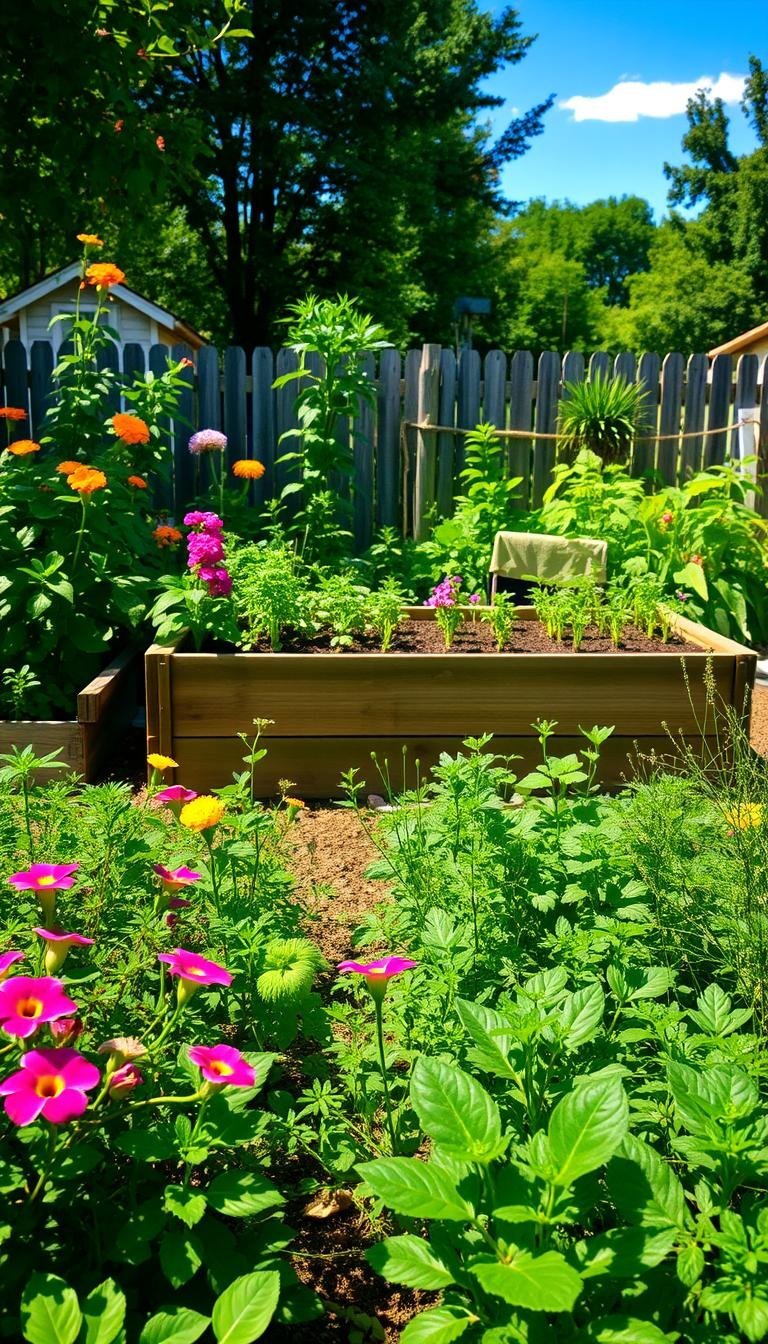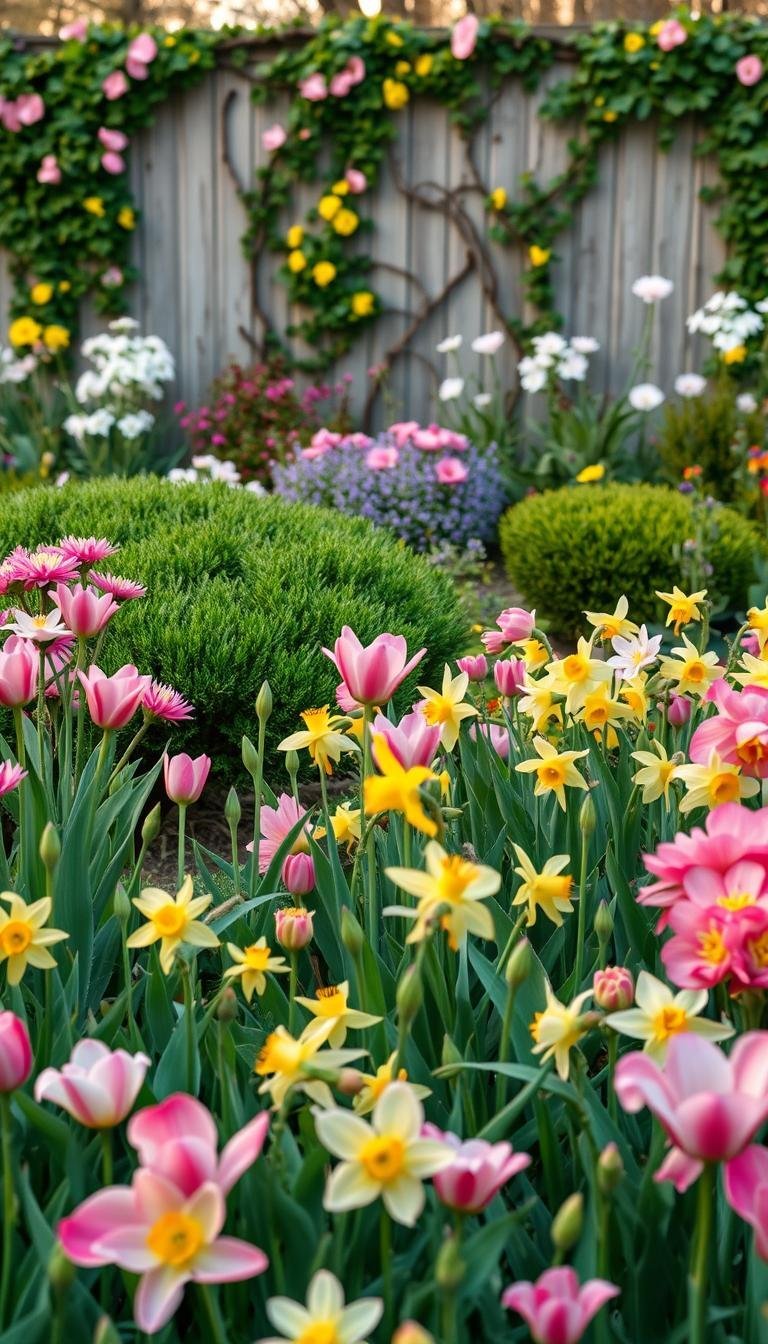This post may contain affiliate links. If you click and buy, we may earn a small commission at no extra cost to you. Learn more.
Make your outdoor area come alive with a Tulips Garden that shines in spring. Tulips bring beauty to any yard, with their vibrant colors and unique shapes. This guide will show you how to grow a beautiful tulip garden, whether it’s your first time or you’re improving your garden.
Find out how to pick the best tulips, when to plant, and how to care for them. This way, your tulips will bloom every year. Get tips on soil, pests, and design to make your garden a highlight of spring. Follow these steps to create a tulip garden that will impress everyone!
Contents
- 1 Introduction to Tulips and Their Beauty
- 2 Choosing the Right Location for Your Tulip Garden
- 3 Planting Tulips: Timing is Everything
- 4 Caring for Tulips: Watering and Fertilization
- 5 Protecting Your Tulips from Pests and Diseases
- 6 Timing for Tulip Blooms
- 7 Creating a Stunning Tulip Display
- 8 Harvesting Tulips for Arrangements
- 9 Fall Preparations After Blooming
- 10 Inspiring Tulip Garden Designs
Introduction to Tulips and Their Beauty
Tulips are more than just spring flowers—they’re a celebration of color and diversity. With thousands of cultivars available, tulip varieties offer endless possibilities for garden design. Whether you prefer bold petals or delicate forms, there’s a type to suit every space.
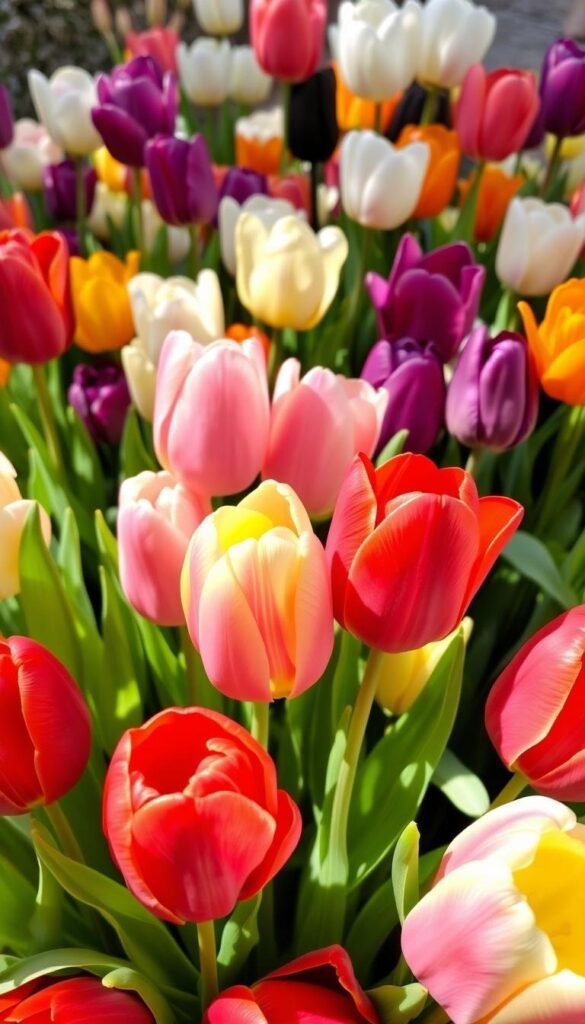
Understanding Tulip Varieties
Modern tulip varieties fall into 15 main categories, each with unique traits. For example:
- Single Early tulips bloom early with simple petals.
- Double Late varieties create dramatic ruffled displays.
- Parrot tulips stand out with fringed edges and vibrant hues.
These differences help gardeners pick plants based on bloom time, height, and aesthetic goals.
The History of Tulips in Gardening
Wild tulips originated in Central Asia, spreading westward along ancient trade routes. By the 17th century, Dutch traders fueled “Tulip Mania,” where rare bulbs traded for exorbitant prices. Today, this legacy lives on in hybrid tulip varieties bred for modern gardens. From Ottoman gardens to Victorian conservatories, their story mirrors human fascination with floral beauty.
Choosing the Right Location for Your Tulip Garden
Your flower garden’s success starts with a good location. The right sunlight and soil are key for tulips to grow well. Here’s how to find and prepare the perfect spot:
Sunlight Requirements
Tulips need lots of light to grow. They should get at least 6 hours of direct sunlight every day. In very hot places, morning sun and afternoon shade help prevent wilting. The best spot is usually in the south in northern U.S. areas.
- Full sun is ideal for most climates
- Avoid dense shade to ensure healthy blooms
- Adjust for regional heat: add partial shade in zones 8–10
Soil Type and Preparation
Soil must drain well to stop bulb rot. Tulips like slightly acidic to neutral soil (pH 6.0–7.0). If your soil is heavy with clay, mix in compost and coarse sand. For sandy soil, add organic matter like peat moss.
- Test soil pH using a home testing kit
- Amend soil with 2–3 inches of compost
- Break up clay soils with 50/50 soil/sand mix
- Till amendments 12 inches deep for root access
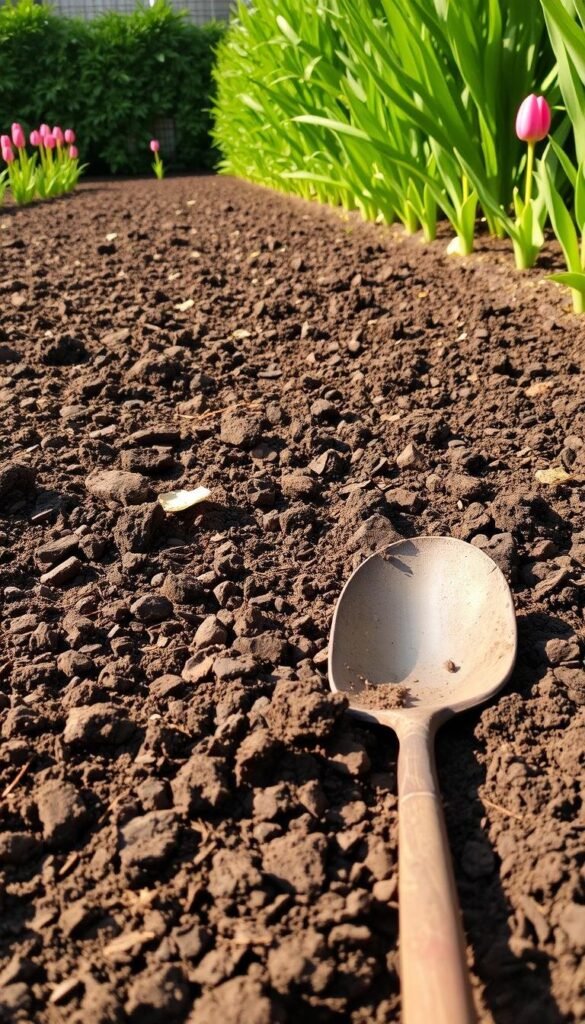
Healthy soil means healthy flowers. Make sure the soil drains well to avoid bulb decay. Mix in amendments 2–3 weeks before planting. This lets the soil settle, setting up your garden for success.
Planting Tulips: Timing is Everything
Timing and technique are key to making tulips bloom beautifully. Follow these steps to bring out their full beauty.
Ideal Planting Seasons
Plant tulip bulbs in fall for the best blooms. The cold weather helps them grow. Here’s when to plant by region:
- USDA Zones 3-5: Mid-September to early October
- Zones 6-8: October to mid-November
- Zones 9-10: December to January (for artificial chilling)
Depth and Spacing Guidelines
Plant bulbs 6-8 inches deep. This is three times their height. Space them 4-6 inches apart for good air flow. Make sure the pointed end is up for growth.
For a stunning look, group bulbs in clusters of 10-15. In pots, use soil that drains well and leave 2 inches at the top.
Pro tip: Mulch helps protect bulbs from frost. Being patient and precise now means fewer surprises later.
Caring for Tulips: Watering and Fertilization
Proper tulip care makes sure your bulbs grow well from planting to bloom. Start with these key steps for healthy growth and bright flowers.
Best Practices for Watering
Water tulips deeply but not too often to avoid wet soil. Aim for 1 inch of water a week when they’re growing, adjusting for rain. Tip: Let the soil dry 2-3 inches deep between waterings to stop rot. Cut back on watering once the foliage turns yellow after blooming.
- Water early mornings to reduce evaporation
- Avoid wetting leaves to prevent disease
- Use drip irrigation for targeted moisture
Fertilizer Recommendations
Feed tulips with a balanced fertilizer when you plant them. For bulbs that are already growing, use a low-nitrogen, high-phosphorus fertilizer like 5-10-10 before buds form. Organic choices include bone meal or compost mixed into the soil at planting.
“Fertilize within 6 weeks of planting for optimal bulb development,” advises the American Bulb Society.
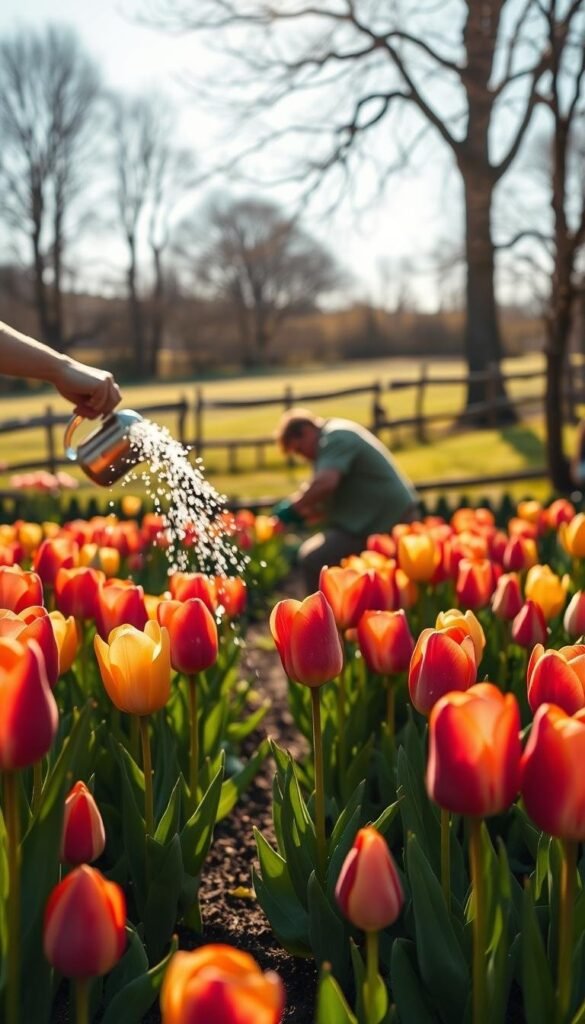
Don’t over-fertilize, as it can weaken blooms. Follow the package instructions. Stop feeding after flowering to help them rest. Keeping up with tulip care ensures strong roots and more blooms every year.
Protecting Your Tulips from Pests and Diseases
Healthy tulip care means keeping plants safe from pests and diseases. Learn to spot threats early and act fast to protect your garden.

Common Pests to Watch For
Deer, squirrels, voles, and aphids love tulips. Use fencing or repellents to keep deer away. Cover beds with mesh to stop squirrels.
For voles, try traps or natural predators like owls. To fight aphids, spray soapy water or introduce ladybugs.
- Deer: Install 8-foot fences or use scent-based repellents.
- Squirrels: Lay chicken wire over soil during planting season.
- Voles: Clear debris to remove hiding spots and use snap traps.
- Aphids: Blast them off plants with a water hose daily.
Identifying and Treating Diseases
Botrytis blight causes fuzzy gray mold on flowers. Remove infected parts and space plants for airflow. Tulip fire shows red streaks on leaves—dig up bulbs and dispose of them.
Viral diseases like mosaic virus distort leaves; always buy certified disease-free bulbs. For severe cases, apply fungicides labeled for tulips. Rotate planting spots yearly to reduce soil-borne pathogens. Healthy soil and proper spacing are key to preventing outbreaks.
Timing for Tulip Blooms
Knowing when your tulips will bloom is key to a colorful garden all season. By understanding how the environment and planting choices affect timing, you can enjoy spring flowers at their best for longer.
Factors Affecting Bloom Time
Several elements control when tulips burst into bloom:
- Varity choice: Early bloomers like ‘Early Harvest’ open in late March, while ‘Darwin Hybrids’ wait until May.
- Planting depth: Deeper planting can delay flowering by up to two weeks in some species.
- Climate zones: USDA zones 3-8 shift bloom windows—check local frost dates for accuracy.
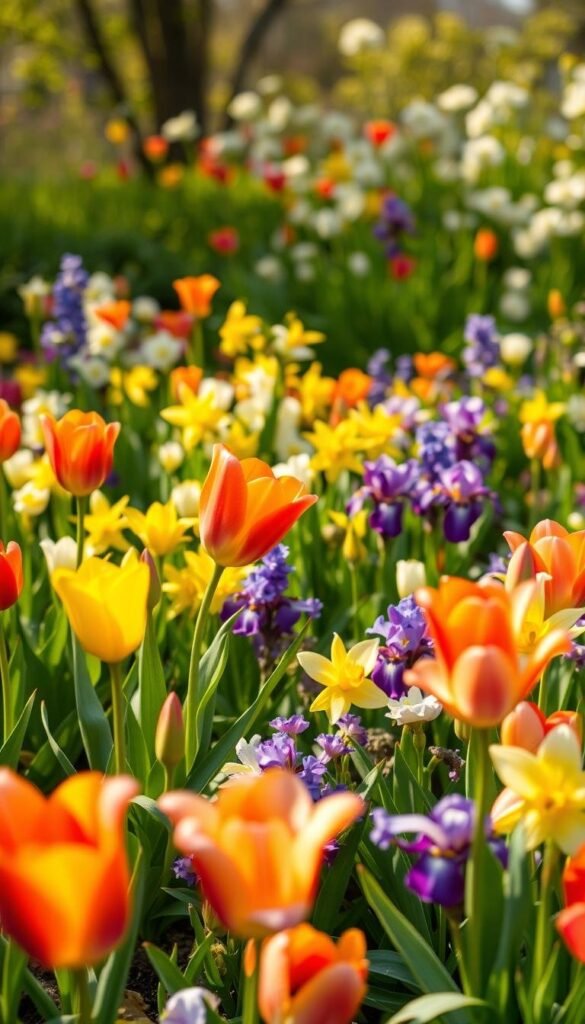
How to Extend the Blooming Period
Create a prolonged display with these strategies:
- Stagger planting dates: Sow batches of the same varity two weeks apart to stretch blooming by 3–4 weeks.
- Combine bloom groups: Mix ‘Apricot Delight’ (early), ‘Red Riding Hood’ (mid), and ‘Purple Passion’ (late) for continuous color.
- Shade management: Position early-blooming tulips under deciduous trees—they’ll flower before tree leaves block sunlight.
“Microclimates like south-facing slopes can shift bloom dates by up to 10 days—use this to your advantage.” – National Garden Bureau
By applying these methods, your garden can showcase spring flowers for up to 8 weeks. Adjust planting strategies based on your region’s last frost date for optimal results.
Creating a Stunning Tulip Display
Turn your tulip garden into a masterpiece with design principles. Whether you want bold contrasts or harmonious blends, landscaping with tulips is full of possibilities.
Color Combinations for Impact

- Complementary schemes: Pair fiery red ‘Apeldoorn’s Elite’ with deep blue delphiniums for a striking contrast.
- Analogous palettes: Mix orange ‘Orange Emperor’ with yellow ‘Golden Melody’ for a warm gradient.
- Monochromatic magic: Layer varying shades of purple, like ‘Queen of Night’ and ‘Blue Parrot’, for depth.
Companion Plants for Tulips
“Pair tulips with plants that respect their bloom timeline—this ensures continuous garden interest.” – Jane Smith, Professional Landscape Designer
Choose partners that complement tulips’ lifecycle:
- Spring bloomers: Pansies and sweet alyssum fill gaps while tulips emerge.
- Post-bloom fillers: Plant hostas or coral bells to hide fading foliage.
- Height hierarchy: Use dwarf tulips like ‘Little Princess’ in front, backed by taller alliums.
Landscaping with tulips is easy when you pair them with different textures. Try feathery ferns or spiky grasses for contrast. Let these tips make your garden a living canvas!
Harvesting Tulips for Arrangements
Make your tulip garden a living art gallery by picking blooms for indoor displays. Timing and care are key to keeping stems bright for weeks. Follow these steps to bring garden beauty indoors.
When to Cut Tulips
Harvest stems when buds show color but are closed. Cut in early morning or evening to avoid heat stress. Choose healthy stems for a balanced tulip garden.
- Look for buds with visible color but tightly closed petals.
- Use clean shears to avoid damaging stems.
- Leave 4–6 inches of stem to support regrowth.
Tips for Long-Lasting Arrangements
Extend vase life with these simple tricks:
- Trim stems at a 45° angle underwater to boost water uptake.
- Change water every 2 days to prevent bacterial growth.
- Refrigerate blooms overnight before arranging to slow opening.
“Cool water (50–68°F) keeps tulips upright and vibrant,” says Master Gardener Sarah Green. “Avoid direct sunlight to prolong blooms.”
Embrace tulips’ natural growth by trimming stems daily. Recut 1 inch off stems every few days to refresh water absorption. Mix tulips with garden accents like eucalyptus or branches from your tulip garden for layered arrangements. Whether in a minimalist vase or wildflower mix, these tips ensure your blooms shine indoors as brightly as they do outdoors.
Fall Preparations After Blooming
After tulips finish blooming, they need more care. Taking good care of them in fall helps them grow strong for next year. Focus on two main steps: taking care of the foliage and planning for next year.
Caring for Tulip Foliage
Let the foliage turn yellow on its own. Green leaves help store energy in tulip bulbs. Don’t cut the leaves too early; they need 6–8 weeks to finish their job.
“Foliage is the battery charger for next year’s blooms.”
Hide fading leaves by planting annuals like impatiens in front. Never braid or tie leaves, as this restricts nutrient flow.
Preparing for the Next Season
- Leave in ground: In mild climates (USDA zones 7–8), mulch over bulbs with 2–3 inches of compost.
- Replanting: In colder zones, dig bulbs after foliage dies. Shake off soil, let dry for 2 weeks, then store in mesh bags in a cool, dry spot.
- Soil prep: Amend soil with bulb food or bone meal if bulbs stay in place.
Keep a garden journal to track which tulip bulbs perform best. Discard shriveled or soft bulbs before replanting. Fall prep ensures healthy growth, bringing vibrant blooms back every year.
Inspiring Tulip Garden Designs
Creative landscaping with tulips turns simple spaces into stunning displays. Whether it’s a small urban garden or a big backyard, these ideas make tulip plantings a personal expression of beauty.
Unique Layout Ideas
Color rivers guide viewers through the garden with single-color tulips. Bulb tapestries mix different tulip varieties in geometric patterns. Layered plantings combine early and late-blooming types for longer color displays.
Even small spaces can have naturalistic drifts that look like wild meadows. These techniques suit any Tulips Garden size, from patios to large country estates.
Seasonal Themes to Consider
Imagine a Tulips Garden inspired by Van Gogh’s bold brushstrokes or a patriotic display with red, white, and blue blooms. Storytelling gardens have staggered planting times for weekly color changes, telling a visual story.
Cottage gardens pair tulips with herbs, while modern designs feature bold monochromatic blocks. Seasonal themes make landscaping with tulips a year-round adventure.
Take photos of your garden yearly to track changes and improve your ideas. Let these concepts inspire your own style—whether blending tulips with lavender or creating a springtime mosaic, every choice tells your story.
To bring you cozy inspiration more efficiently, we sometimes use AI to assist in content creation — but every word and idea is carefully shaped by our team. See our AI Disclosure for more info.

